[Note: Because of the sheer number of photographs, I decided to use flickr to host this entry’s images. The pictures are smaller than my photos usually are; however, if you want to see a particular image in a larger size, simply click on it! Or, if you want to view the entire set of photos in flickr, click here.]
Today I decided to leave the city on my own and go off on a bit of an adventure. I meant to get up at the crack of dawn, but you know how good I am at waking up at the crack of dawn. I left my house around noon, took the subway to the Seongdangmot station, and made my way to the Seobu Bus Terminal, where I caught a bus to Haeinsa. Haeinsa (wikipedia entry) is one of the three biggest Buddhist temples in South Korea, and it was originally founded in 802. The temple is most well known for being the home of the Tripitaka Koreana (wikipedia entry), a collection of over 80,000 wooden printing blocks dating from the 1300s, which contain all of the Buddhist Scriptures.
I’d been inside the Seobu Bus Station before back in 2001, when Melissa and I went to Gyeong Ju a couple of times – and that time she and I accidentally got on the wrong bus to tiny village of Choggye. I saw the sign for tickets to Choggye, and made very sure I didn’t go to the wrong place this time… I asked several different people, and made absolutely sure I got on the right bus! The trip cost little more than $4, and lasted a little over an hour. The route started on the freeway, and ended after winding its way up a narrow road to a spot high in the mountains. The scenery along the way was beautiful: bright green rice fields, rocky streams, and gorgeous forests which were beginning to change into fall colors here and there. The bus reached the end of the line and I disembarked. Unfortunately, at the place where the trip ended, the signage for the temple was a little sparse, and it took me a while to find the path to the place. (It turned out that the stop for the temple was actually one stop before the end of the line, so I had to backtrack a bit. Luckily, the weather and scenery were wonderful, so it wasn’t a problem.)
Once I found the right path, I had to hike approximately one kilometer uphill, alongside a pleasant river, in order to reach the temple of Haeinsa. The temple was beautiful. Sadly, I know very, very little about Buddhism, so there I was, roaming about taking tons of pictures of all sorts of things which mean little or nothing to me. I definitely want to learn more about Buddhism and its Korean variant. I’ve even added a few books on this topic to my Amazon wish list, and perhaps I’ll get around to reading them some day.
Today I decided to leave the city on my own and go off on a bit of an adventure. I meant to get up at the crack of dawn, but you know how good I am at waking up at the crack of dawn. I left my house around noon, took the subway to the Seongdangmot station, and made my way to the Seobu Bus Terminal, where I caught a bus to Haeinsa. Haeinsa (wikipedia entry) is one of the three biggest Buddhist temples in South Korea, and it was originally founded in 802. The temple is most well known for being the home of the Tripitaka Koreana (wikipedia entry), a collection of over 80,000 wooden printing blocks dating from the 1300s, which contain all of the Buddhist Scriptures.
I’d been inside the Seobu Bus Station before back in 2001, when Melissa and I went to Gyeong Ju a couple of times – and that time she and I accidentally got on the wrong bus to tiny village of Choggye. I saw the sign for tickets to Choggye, and made very sure I didn’t go to the wrong place this time… I asked several different people, and made absolutely sure I got on the right bus! The trip cost little more than $4, and lasted a little over an hour. The route started on the freeway, and ended after winding its way up a narrow road to a spot high in the mountains. The scenery along the way was beautiful: bright green rice fields, rocky streams, and gorgeous forests which were beginning to change into fall colors here and there. The bus reached the end of the line and I disembarked. Unfortunately, at the place where the trip ended, the signage for the temple was a little sparse, and it took me a while to find the path to the place. (It turned out that the stop for the temple was actually one stop before the end of the line, so I had to backtrack a bit. Luckily, the weather and scenery were wonderful, so it wasn’t a problem.)
Once I found the right path, I had to hike approximately one kilometer uphill, alongside a pleasant river, in order to reach the temple of Haeinsa. The temple was beautiful. Sadly, I know very, very little about Buddhism, so there I was, roaming about taking tons of pictures of all sorts of things which mean little or nothing to me. I definitely want to learn more about Buddhism and its Korean variant. I’ve even added a few books on this topic to my Amazon wish list, and perhaps I’ll get around to reading them some day.
Left: I've seen many variations of the turtle-with-monument-on-its-back around many temples, but this was the first I'd ever seen that was a turtle-shelled dragon. It was also enormous! I found this (along with many turtle-monuments) on the way to the temple. Can someone tell me what they are?
Right: The path to the temple criscrossed this stream numerous times.
Right: The path to the temple criscrossed this stream numerous times.
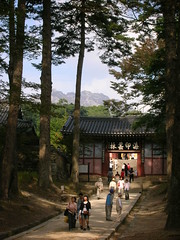
The entrance to the temple. Note the mountaintops in the background.
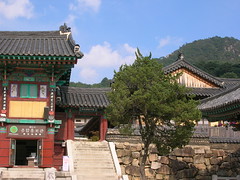
Inside the temple.
Below are some of the things I wish I knew more about:
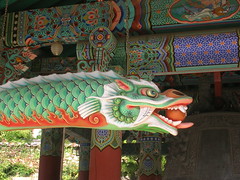
The fish-dragon is hollow and can be used as a drum, or it can be swung to ring a gong.
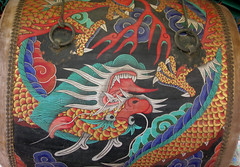
The dragon above adorns the side of a drum, located near the fish-dragon.
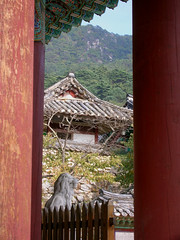
An interesting shot taken on Haeinsa grounds.
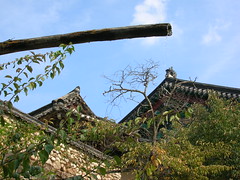
If you view this shot large, you can see holy water dripping from the wooden pipe. It is collected in a cistern, from whence it can be drunk and/or collected.
The images below are all from the inside of the Haeinsa Temple. Most aren't labeled, as I have no information with which to label them - sorry!
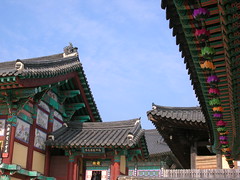
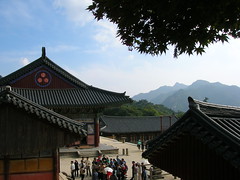
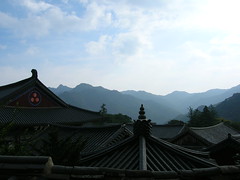
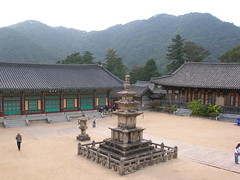
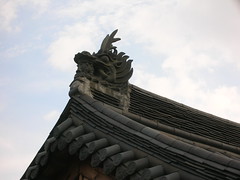
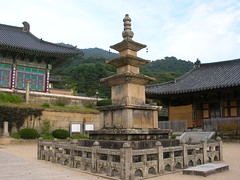
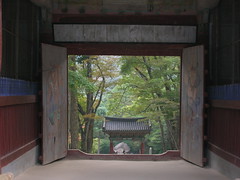
Looking out the temple gate
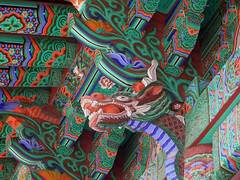
Detail of a temple carving
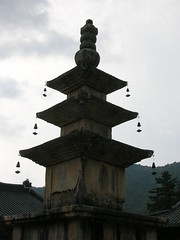
Temple Pagoda
The temple had many small shrines and several large ones. I took some pictures of the insides of the various shrines, although they aren’t all that great as I did my best to take my pictures surreptitiously, so as not to disturb the worshippers.
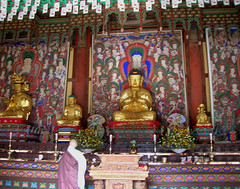
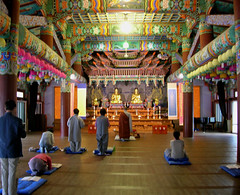
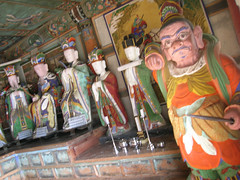
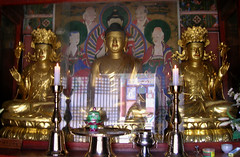
At the topmost level of the temple sits the buildings which house the Tripitaka Koreana. Like I mentioned above, it’s a collection of over 80,000 wooden blocks covered with Buddhist Scripture, to be used for printing purposes. The building was designed in such a way to regulate its internal temperature and humidity, and to thus preserve the wooden blocks. They’ve survived undamaged for over 600 years! Apparently the Korean government had planned to construct a state of the art storage facility for the blocks, but nothing they came up with worked as well as the building designed for that purpose at Haeinsa. Quite an impressive display of ancient architectural technology! I was able to view this building from the outside. While visitors are not allowed inside, the blocks of wood can be seen through the windows.
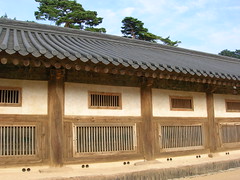
This is the building which stores the Tripitaka Koreana.
The blocks of wood can be seen through the window-slats.
After exploring the temple thoroughly, and taking numerous pictures, I stopped in at the temple’s information center. There I met a very nice woman who worked there, and who (for roughly $5) allowed me to print a segment from a replica of one of the pieces of the Tripitaka Koreana entitled The Heart of the Prajna Paramita Sutra on a piece of parchment. The pictures were taken by a French tourist.
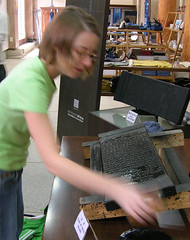
Me, smearing the ink on the printing block
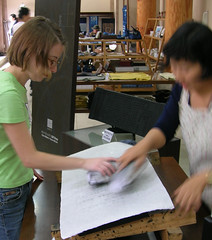
Tapping the parchment onto the ink-block
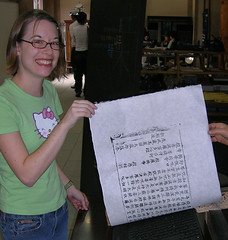
Removing the parchment...
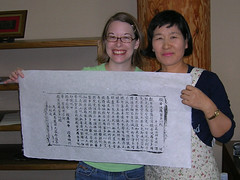
Behold! The final product! I am such a tourist.
I have no idea what the parchment means, even though I was given a nice English translation of what I printed on the parchment. Here’s what it says:
The Heart of the Prajna Paramita Sutra
The free seeing Bodhisattva of compassions, while in profound contemplation of Prajna Paramita, beheld five skandhas as empty in their being and thus crossed over all sufferings. O-oh Sariputra, what is seen does not differ from what is empty, nor does what is empty differ from what is seen; what is seen is empty, what is empty is seen. It is the same for sense perception, imagination, mental function and judgment. O-Oh Sariputra, all the empty forms of these dharmas neither come to be nor pass away and are not created or annihilated, neither impure or pure, and cannot be increased or decreased. Since in emptiness nothing can be seen, there is no perception, imagination, mental function or judgment. There is no eye, ear nose, tongue, body or consciousness. Nor are there sights, sounds odors, tastes, objects or dharmas. There is no visual world, world or consciousness or other world. There is no ignorance or extinction of ignorance and so forth down to no ageing and death and also extinction of ageing and death. There is neither suffering, causation, annihilation nor path. There is no knowing or unknowing. Since nothing can be known, Bodhisattvas rely upon Prajna Paramita and so their minds are unhindered. Because there is no hindrance, no fear exists and they are far from inverted and illusory thought and thereby attain nirvana. All the Buddhas in the three periods of time fully accomplished the an-nut-ta-ra-sam-yak sambod-hi by relying upon Prajna Paramita. Therefore, Prajna Paramita is known as the most divine mantra, the incomparable mantra, destroyer of all suffering! Since what is true is not in vain, listen to the mantra of the Pranja Paramita – it goes like this:
The Heart of the Prajna Paramita Sutra
The free seeing Bodhisattva of compassions, while in profound contemplation of Prajna Paramita, beheld five skandhas as empty in their being and thus crossed over all sufferings. O-oh Sariputra, what is seen does not differ from what is empty, nor does what is empty differ from what is seen; what is seen is empty, what is empty is seen. It is the same for sense perception, imagination, mental function and judgment. O-Oh Sariputra, all the empty forms of these dharmas neither come to be nor pass away and are not created or annihilated, neither impure or pure, and cannot be increased or decreased. Since in emptiness nothing can be seen, there is no perception, imagination, mental function or judgment. There is no eye, ear nose, tongue, body or consciousness. Nor are there sights, sounds odors, tastes, objects or dharmas. There is no visual world, world or consciousness or other world. There is no ignorance or extinction of ignorance and so forth down to no ageing and death and also extinction of ageing and death. There is neither suffering, causation, annihilation nor path. There is no knowing or unknowing. Since nothing can be known, Bodhisattvas rely upon Prajna Paramita and so their minds are unhindered. Because there is no hindrance, no fear exists and they are far from inverted and illusory thought and thereby attain nirvana. All the Buddhas in the three periods of time fully accomplished the an-nut-ta-ra-sam-yak sambod-hi by relying upon Prajna Paramita. Therefore, Prajna Paramita is known as the most divine mantra, the incomparable mantra, destroyer of all suffering! Since what is true is not in vain, listen to the mantra of the Pranja Paramita – it goes like this:

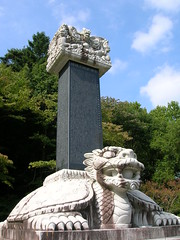
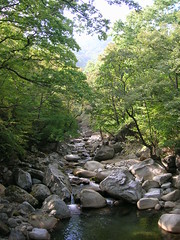
6 comments:
Tres interesting!
Never made it to the temples when I was stationed in Korea 10 years ago, but my interest was kindled in Asian Culture and religions, hence the uber-useful B.A. in Asian Studies from UT in 2000.
My understanding (hazy and possibly way way off) is that the predominating Asian creation myth has the universe supported on the back of a turtle. That may explain the presence of these turtles near religious sites.
~Matt~
BTW, my Uncle is a Buddhist monk, and I would love to get my hands on one of those parchments for him. Your pictures, as always, are excellent!
~Matt~
the scriptures are very interesting. in hinduism, when mantras end, they usually end in "sva(aa)-ha(aa)" in a melodic way. The swamis use it. A lot of non-English wordings originate from Sanskrit -- like "Putra" means son. That's all I can throw in terms of meaning, if it helps. Hindu mantras are so long, I can't sit through them. I ask my Mom to call me for the good food when it's all over
Hi, I'm in Daejeon, and am wondering if this temple is north or south of Daegeu. Is the name of the town actually Haeinsa? I also write lots about Korea and Asia in my blog at http://360.yahoo.com/bunni56531
Thanks for the interesting read!
Matt - Thanks for the info. I'll try to learn more while I'm here. If I make it back to Haeinsa, I'll pick up one of the parchments for you.
Khakra - Thanks for the info as well!
Ladyexpat - it's located south-east of Daegu. There isn't a town there, although a small village has grown up in order to support the tourists/worshippers coming to the temple. The bus I took was the bus from Daegu to Haeinsa (unlike, for example, when one takes the bus to Gyeong Ju in order to visit Bulguksa)
Who knows where to download XRumer 5.0 Palladium?
Help, please. All recommend this program to effectively advertise on the Internet, this is the best program!
Post a Comment